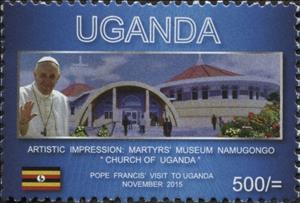Stamp: Martyrs' Museum Namugongo (Uganda 2015)
Martyrs' Museum Namugongo (Uganda 2015)
27 November (Uganda ) within release Pope Francis' Visit to Uganda goes into circulation Stamp Martyrs' Museum Namugongo face value 500 Ugandan shilling
| Stamp Martyrs' Museum Namugongo in catalogues | |
|---|---|
| WADP Numbering System - WNS: | WAD:UG011.15 |
Stamp is horizontal format.
Also in the issue Pope Francis' Visit to Uganda:
- Stamp - Pope Francis' Visit to Uganda face value 500;
- Stamp - Pope Francis' Visit to Uganda face value 700;
- Stamp - Pope Francis' Visit to Uganda face value 1000;
- Stamp - Pope Francis' Visit to Uganda face value 1100;
- Stamp - Pope Francis' Visit to Uganda face value 1800;
- Stamp - Pope Francis' Visit to Uganda face value 1900;
- Stamp - Pope Francis' Visit to Uganda face value 2700;
- Stamp - Pope Francis' Visit to Uganda face value 3400;
- Stamp - Pope Francis' Visit to Uganda face value 10000;
- Stamp - Pope Francis' Visit to Uganda face value 10000;
- Mini Sheet - Pope Francis' Visit to Uganda face value ;
- Mini Sheet - Pope Francis' Visit to Uganda face value ;
- Stamp - Martyrs' Museum Namugongo face value 500;
- Stamp - Pope Francis face value 700;
- Stamp - Pope Francis face value 1000;
- Stamp - Pope Francis face value 1100;
- Stamp - Pope Francis face value 1800;
- Stamp - Pope Francis face value 1900;
- Stamp - Pope Francis face value 2700;
- Stamp - Pope Francis face value 3400;
- Stamp - Munyonyo Martyrs' Shrine face value 10000;
- Souvenir Sheet - Munyonyo Martyrs' Shrine face value 10000;
- Stamp - Uganda Martyrs' Shrine Namugongo face value 10000;
- Souvenir Sheet - Uganda Martyrs' Shrine Namugongo face value 10000;
Stamp Martyrs' Museum Namugongo it reflects the thematic directions:
A church building, often simply called a church, is a building used for Christian religious activities, particularly worship services. The term in its architectural sense is most often used by Christians to refer to their religious buildings, but it is sometimes used (by analogy) for buildings of other religions. In traditional Christian architecture, the church is often arranged in the shape of a Christian cross. When viewed from plan view the longest part of a cross is represented by the aisle and the junction of the cross is located at the altar area. Towers or domes are often added with the intention of directing the eye of the viewer towards the heavens and inspiring church visitors. Modern church buildings have a variety of architectural styles and layouts; many buildings that were designed for other purposes have now been converted for church use; and, similarly, many original church buildings have been put to other uses. The earliest identified Christian church was a house church founded between 233 and 256. During the 11th through 14th centuries, a wave of building of cathedrals and smaller parish churches occurred across Western Europe. A cathedral is a church, usually Roman Catholic, Anglican, Oriental Orthodox or Eastern Orthodox, housing the seat of a bishop.
The pope (Latin: papa, from Ancient Greek: πάππας, romanized: páppas, lit. 'father') is the bishop of Rome and the visible head[a] of the worldwide Catholic Church. He is also known as the supreme pontiff, Roman pontiff, or sovereign pontiff. From the eighth century until 1870, the pope was the sovereign or head of state of the Papal States, and since 1929 of the much smaller Vatican City state.From a Catholic viewpoint, the primacy of the bishop of Rome is largely derived from his role as the apostolic successor to Saint Peter, to whom primacy was conferred by Jesus, who gave Peter the Keys of Heaven and the powers of "binding and loosing", naming him as the "rock" upon which the Church would be built. The reigning pope is Francis, who was elected on 13 March 2013.
Religion is any cultural system of designated behaviors and practices, world views, texts, sanctified places, ethics, or organizations, that relate humanity to the supernatural or transcendental. Religions relate humanity to what anthropologist Clifford Geertz has referred to as a cosmic "order of existence". Different religions may or may not contain various elements ranging from the "divine", "sacred things", "faith", a "supernatural being or supernatural beings" or "some sort of ultimacy and transcendence that will provide norms and power for the rest of life". Religious practices may include rituals, sermons, commemoration or veneration (of deities), sacrifices, festivals, feasts, trances, initiations, funerary services, matrimonial services, meditation, prayer, music, art, dance, public service, or other aspects of human culture. Religions have sacred histories and narratives, which may be preserved in sacred scriptures, and symbols and holy places, that aim mostly to give a meaning to life. Religions may contain symbolic stories, which are sometimes said by followers to be true, that have the side purpose of explaining the origin of life, the Universe and other things. Traditionally, faith, in addition to reason, has been considered a source of religious beliefs. There are an estimated 10,000 distinct religions worldwide. About 84% of the world's population is affiliated with one of the five largest religions, namely Christianity, Islam, Hinduism, Buddhism or forms of folk religion.


